49 Traditional Indian Foods to Taste in 2025
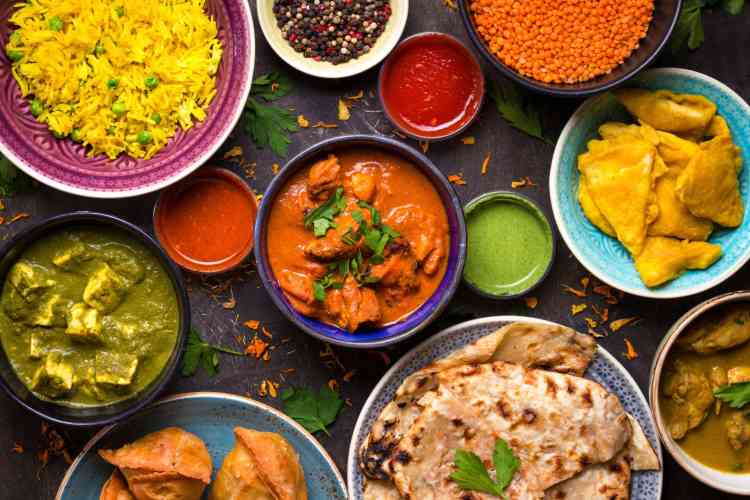
Coming from one of the most populous countries in the world, Indian food reflects the unique blend of cultures and regional identities found throughout the country. Shaped by its long and tumultuous history, Indian cuisine carries influences of colonizers from the East and the West as well as a range of religious beliefs and practices.
As the Association for Asian Studies notes, food in India often acts as a powerful marker of identity, tied to caste, religion, family and community. This deep connection makes the national food of India not just flavorful, but also culturally rich and deeply symbolic.
What makes Indian food so different? With distinct regional delicacies, a unique cultivation of cultural and religious influences and the signature aromatic spices, there is much to explore. The iconic breads and widely recognized curries are enhanced by the bustling street food culture, celebratory dishes and ancient beverages that make up the vibrant world of Indian food.
To help guide those curious to try this bold and colorful cuisine, here are 49 traditional Indian foods we recommend adding to your foodie bucket list.
Jump to Section
- How We Selected These Popular Indian Dishes
- Indian Breads
- Indian Street Foods
- Indian Appetizers
- Indian Dishes
- Indian Desserts
- Indian Drinks
- Indian Spices
- Get a Taste of Traditional Indian Foods
How We Selected These Popular Indian Dishes
To curate this list of India’s most famous foods, our editorial team undertook in-depth research with the aim of capturing the rich diversity and cultural popularity of Indian food.
In addition, we turned to the team at Cozymeal’s culinary expertise to expand on our research, incorporating cooking tips, food pairings and more. This experience comes from years of organizing cooking classes, food tours and other chef-led events across the globe, allowing the team to gain valuable insight into the dishes that resonate most within local communities and why they matter.
Finally, we ensure that the selection of Indian food in this guide met the following criteria:
- Regional Representation: Dishes from each of India’s distinct regions are included to reflect a broad range of flavors and cooking techniques.
-
Cultural Significance: Many dishes were selected for their ties to religious practices, festivals or family traditions, offering a glimpse into the cultural stories behind the food.
-
Popularity and Recognition: We focused on foods that are beloved across India or gaining international recognition, from daily staples to treasured regional specialties.
-
Culinary Variety: This list includes snacks, mains, breads, desserts and beverages to capture the full spectrum of Indian dining.
-
Authenticity and Tradition: Guided by culinary professionals, we prioritized traditional recipes and cooking methods that stay true to the original character of each dish.
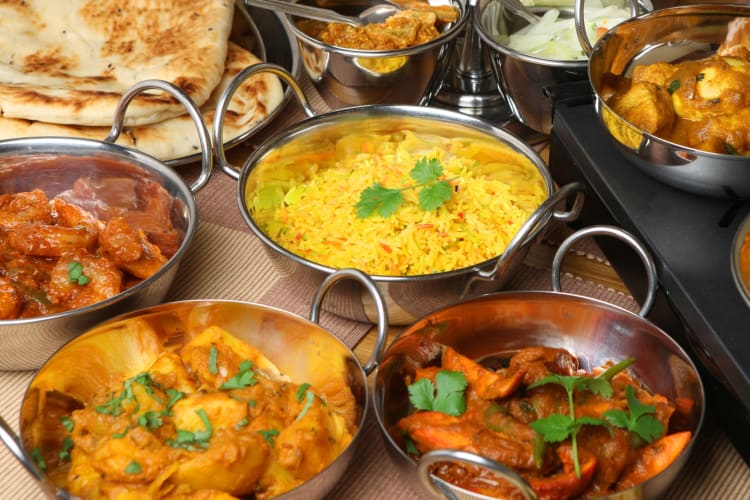
Book a Local Food Tour Now Explore your city's best bites, esteemed eateries and hidden gems with a top-rated tour guide. Book Now
Indian Breads
As in many global cuisines, bread is a foundational element of Indian food. Although often similar in ingredients and appearance, different styles of bread popular throughout the Indian subcontinent are distinguished by distinct cooking techniques, textures or types of flours, ranging from pillowy flatbreads or thin crêpes to stuffed dough or crisp puffs.
This deep-rooted presence of bread in Indian food can be traced back thousands of years. According to the India Brand Equity Foundation, bread was already a dietary staple during the Indus Valley Civilization (3000–1500 BCE), a flourishing trade society whose evolving food culture laid the groundwork for the diversity of breads enjoyed across India today.
Integral to the Indian food experience, bread is eaten as an appetizer with various chutneys, dips or sauces as well as to accompany a snack or meal by soaking up the rich curries and gravies common to Indian food.
1. Naan
The most widely recognized Indian bread is soft, bubbly naan. This unleavened flatbread can be baked or fried and frequently appears as an accompaniment at Indian restaurants in the United States and around the world.
Traditionally, naan is cooked in a tandoor, a cylindrical clay or metal oven with a high cooking temperature. The signature bread is served plain or with butter, garlic and/or chilies. We’ve had it every way and it’s always a comforting essential that brings the whole meal together.
- Pairs With: Butter chicken, paneer tikka masala, coconut curry chickpeas or anything saucy. It is perfect for scooping and soaking.
- Spice Level: Mild unless topped with chilies.
- Suitable For: Vegetarian diets; vegan versions are possible if made without yogurt, milk or ghee.
- Cooking Notes: Requires high heat. A cast-iron skillet or pizza stone works well for homemade versions.
- Where To Buy: Available fresh or frozen at Indian markets and many mainstream grocery stores.
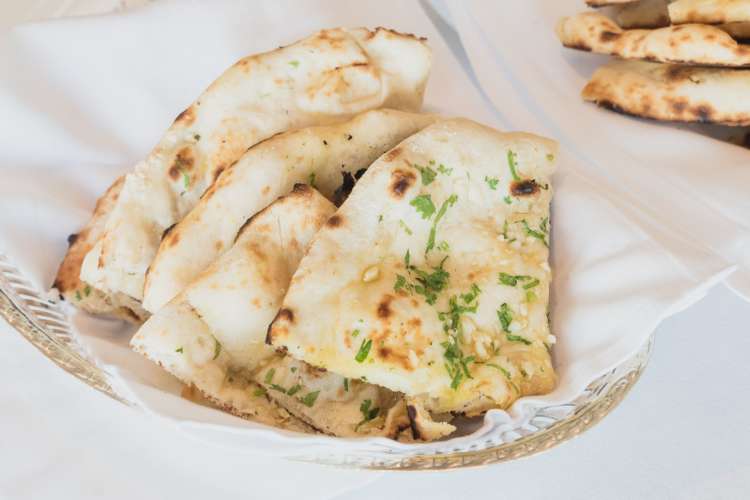
2. Chapati
Chapati is an unleavened flatbread made of finely ground whole wheat flour mixed into dough with water and salt that is cooked on a tava, or flat skillet. This ancient style of bread gets its name from the Hindi word chapat, which means slap or flat.
The word describes the traditional method of preparing the dough by wetting one’s palms and slapping the dough between them. We’ve seen chapati made fresh in home kitchens and small roadside eateries, and there’s something satisfying about the simplicity of it, especially when it’s warm and puffed right off the pan.
This Indian food, known as roti in other parts of the world, is also foundational to a number of other cuisines across Asia, the Middle East and the Caribbean.
- Pairs With: Everyday dishes like dals, dry curries, sautéed vegetables and even sweet spreads for breakfast.
- Spice Level: Low
- Suitable For: Vegetarian, vegan and dairy-free diets.
- Cooking Notes: Just whole wheat flour, water and salt. A flat skillet or cast-iron pan gives the best result.
- Where To Buy: Best fresh from Indian restaurants or home kitchens, but packaged versions are also available in Indian grocery stores.
3. Paratha
Paratha is another style of unleavened, whole-wheat flatbread and a quintessential Indian food. Thicker and more substantial than naan or chapati, paratha is prepared by coating the dough with ghee (a type of clarified butter) or oil and folding repeatedly, similar to making puff pastry, using a lamination technique.
We love how that extra layering gives each bite a rich, flaky texture that’s especially satisfying hot off the pan. It might also be layered or stuffed with other ingredients such as spiced vegetables, potatoes, lentils or paneer, a soft Indian cheese. Layered and stuffed paratha is finished with a shallow fry and often enjoyed for breakfast or as an afternoon snack.
- Pairs With: Plain yogurt, pickles (achar), chutneys or even just a pat of butter; makes a great standalone snack or a side to a pumpkin curry soup.
- Spice Level: Varies by stuffing. Plain is mild, but spiced fillings can bring the heat.
- Suitable For: Vegetarian; can be made vegan if using oil instead of ghee and skipping paneer.
- Cooking Notes: Rolled, folded and pan-fried. Takes more effort than chapati but the flaky payoff is worth it.
- Where To Buy: Freshly made at Indian restaurants or frozen versions (stuffed and plain) are available at Indian grocery stores.
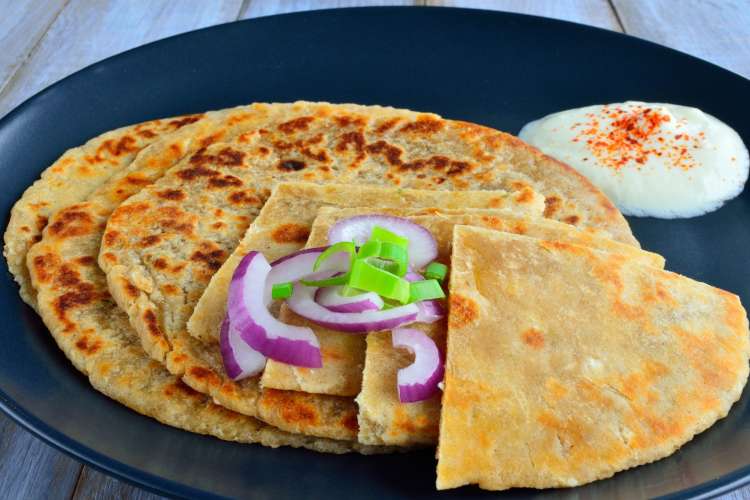
4. Papadam
Papadam is a thin, deep-fried bread traditionally made with black gram bean flour that is either fried or cooked in dry heat until crisp. Perhaps more similar to a chip or tortilla, papadams are often served with Indian food accompaniments or toppings, and eaten as an appetizer or alongside a meal.
The texture is light and brittle with a satisfying crunch, and the flavor can range from plain and nutty to spicy depending on the seasoning.
- Pairs With: Chutneys, raita, dips, lime pickle, chopped onions, chilies or even crumbled over rice and curry for extra crunch.
- Spice Level: Low to spicy, depending on the seasoning.
- Suitable For: Vegetarian, vegan and gluten-free diets (check the label to confirm).
- Cooking Notes: Cook over an open flame or deep-fry. They puff and crisp in seconds.
- Where To Buy: Widely available in packaged form at Indian grocery stores and some international aisles in chain grocery stores.
Indian Street Foods
Street food is central to Indian food culture, with each region, state and city having its own delicacies and local favorites. However, many regional Indian street foods can be found across the country, just under different names or spellings.
Most street foods are simple, filling dishes that are easy to make and eat on the go. But, the best Indian street food is still rich with the bold flavors and aromas of fried dough, savory vegetables and toasted spices.
5. Samosas
Arguably the most popular street food in India, samosas are fried or baked pastry pockets with a savory filling such as spiced potatoes, onions and peas. With origins dating back to around the 10th century, versions of samosas with different shapes and fillings can be found throughout Asia, Africa and the Middle East.
Since its creation, the samosa has become an iconic Indian food recognized all around the world. If you’ve ever bitten into one fresh from a street vendor or homemade batch, you’ll know why; they strike the perfect balance of flaky, spicy and satisfying.
- Pairs With: Mint or tamarind chutney.
- Spice Level: Mild to medium. Depends on the filling and added chilies.
- Suitable For: Vegetarian by default, though meat versions are also common; vegan-friendly if no dairy is used in the pastry.
- Cooking Notes: Folding dough into triangles and deep-frying or baking. Store-bought wrappers make it easier at home.
- Where To Buy: Fresh at Indian restaurants and street stalls. Fresh and frozen versions are available at Indian and chain grocery stores.
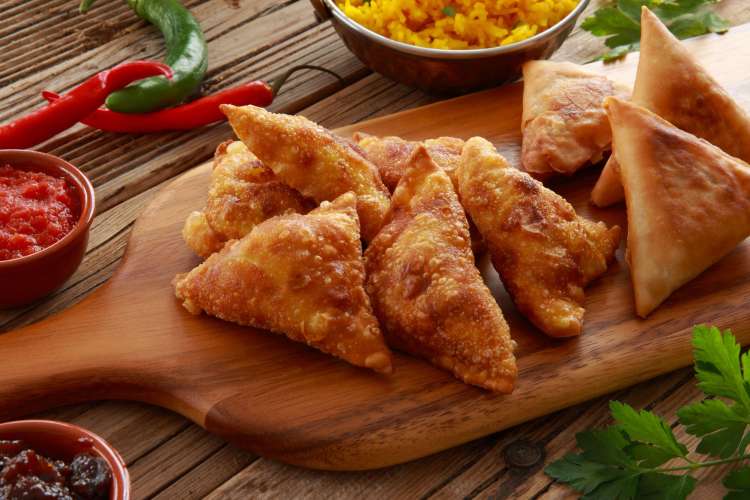
6. Chaat
Chaat actually refers to an entire category of Indian food popular throughout the country in street stalls and roadside stands. Combining aromatic spices and tangy sauces, chaat blends elements that are sweet, salty, crunchy, spicy and savory into one dish bursting with flavor and texture sensations.
Although every chaat may look a little different, versions of this unique Indian food usually share a similar design. Begin with a starchy base such as samosas, puffed rice or fried bread. Next, add lots of vegetables such as raw onion, boiled potatoes or chopped tomatoes.
A sweet, spicy or tangy chutney is then poured over the vegetables, followed by a dusting of chaat masala spice blend to give the chaat its signature flavor. Finally, finish the chaat with a sprinkle of something crispy or fried such as fried potato bits, crunchy chickpeas or deep-fried noodles.
Aloo chaat is a popular potato-based version to look for if you want to give chaat a try. We’ve had this popular Indian dish served in paper bowls on busy streets and in Michelin Star Indian restaurants; no matter where you try it, the bold flavors and textures always surprise you in the best way.
- Pairs With: Goes well with masala chai or sweet lassi.
- Spice Level: Medium to spicy, but can be adjusted with less chutney or masala.
- Suitable For: Vegetarian; vegan if dairy-based chutneys or yogurt are skipped.
- Cooking Notes: Can be assembled quickly with prepped ingredients; chaat masala is key.
- Where To Buy: Best from Indian street vendors or chaat shops. Also available in some Indian restaurants and as DIY kits in Indian grocery stores.
7. Pani Puri
Pani puri is a unique Indian street food experience that goes by many names throughout the country, depending on the region. It is believed to have originated in the northeastern state of Bihar.
Enjoying pani puri is a fully interactive experience. You use your thumb to poke a hole in one side of a round, hollow puri, a deep-fried crisp flatbread, which is then filled with a mixture of flavored water, chili powder, chaat masala, tamarind chutney, potatoes, chickpeas or onions, although spices and fillings vary across regions.
Pop the entire puri in your mouth to experience an explosion of vibrant flavors and textures. It’s fast, fun and surprisingly refreshing, especially when served cold. Trying these from a busy street vendor adds to the appeal, as the crunch and tangy water are best enjoyed fresh.
- Pairs With: Best enjoyed on its own as a snack, often followed by something sweet like gulab jamun or kulfi.
- Spice Level: Tangy and mild to fiery.
- Suitable For: Vegetarian and often vegan. Check that the flavored water and chutneys are dairy-free.
- Cooking Notes: Ready-made puris are filled just before serving to keep them crisp; flavored water and chutneys can be homemade or store-bought.
- Where To Buy: Fresh from street vendors is best. You can also find pani puri kits at Indian grocery stores or make it at home with pre-packed puris.

8. Bhelpuri
Bhelpuri is a crunchy snack made of puffed rice served in the style of chaat. It combines sweet, sour and spicy flavors with contrasting textures from a variety of chutneys, vegetables and crunchy toppings.
It’s the kind of snack that keeps you going back for another bite: crisp, tangy and just messy enough to be fun. You’ll want to eat this as fresh as possible, as the puffed rice softens quickly once the sauces are mixed in.
- Pairs With: Masala chai or on its own as a light afternoon snack.
- Spice Level: Medium but easily adjustable by reducing spicy chutneys.
- Suitable For: Vegetarian and vegan (as long as yogurt isn't added).
- Cooking Notes: Quick to assemble with puffed rice, chopped veggies, chutneys and sev (crunchy noodles); best eaten immediately to avoid sogginess.
- Where To Buy: Often sold by street vendors. DIY kits and puffed rice mixes are available in Indian grocery stores.
9. Kachori
Another popular deep-fried Indian food that goes by many names is kachori. Similar to an empanada, kachori are made with a dough of fine flour stuffed with lentils, beans, vegetables or onions and spices with rich gravy or bold chutney.
- Pairs With: Tamarind or mint chutney, potato-based gravies, yogurt or sev.
- Spice Level: Low to high, depending on fillings.
- Suitable For: Vegetarian (vegan-friendly if ghee is substituted with oil).
- Cooking Notes: The dough is filled and sealed before deep-frying. It takes some prep, but it is worth the effort.
- Where To Buy: Available fresh from Indian snack shops and bakeries. Frozen versions can be found in Indian grocery stores.
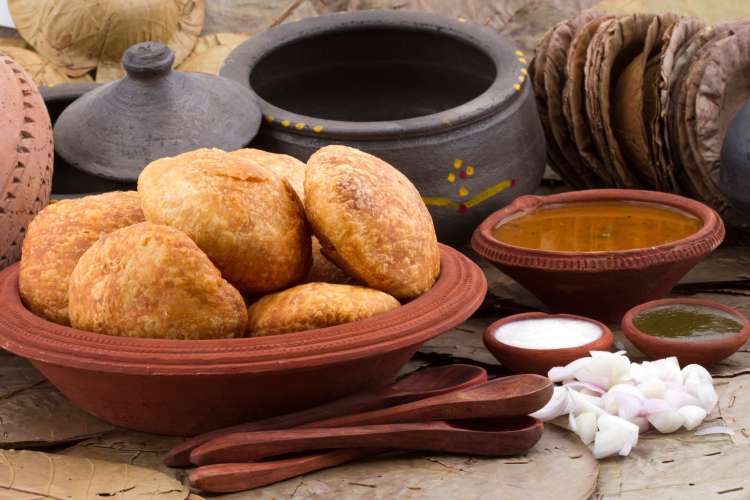
10. Chole Bhature
A typical Punjabi street food, chole bhature, also known as chana bhatura, consists of chickpeas (chana) in a spicy sauce served with puffed, fried bread similar to a puri. This simple dish is often enjoyed for breakfast, as a street food snack or a complete meal accompanied by onions, pickled vegetables or chutneys.
- Pairs With: Sliced onions, green chilies, tangy pickles and mint or tamarind chutney.
- Spice Level: Medium to high, but can be adjusted with yogurt or extra bread on the side.
- Suitable For: Vegetarian; vegan if ghee or dairy is not used in the preparation.
- Cooking Notes: Chole is simmered with tomatoes and spices; bhature dough is fermented slightly and deep-fried for puffiness.
- Where To Buy: Found at North Indian restaurants and street food stalls. Instant mixes and ready-to-eat options are also available in Indian grocery stores.
11. Matar Kulcha
Another favorite street food from North India is matar kulcha. This simple snack consists of a soft flatbread served with spiced white pea gravy and is one of the most famous street foods in Delhi.
For us, this dish stands out for its balance of flavors and straightforward preparation. The soft kulcha soaks up the tangy, mildly spiced white peas perfectly, making it filling without being heavy. It’s easy to see why this is a go-to street food for so many locals.
- Pairs With: Sliced onions, lemon wedges and green chutney.
- Spice Level: Mild to moderate, often more tangy than hot.
- Suitable For: Vegetarian and vegan (as long as the kulcha is made without dairy).
- Cooking Notes: The peas are soaked and cooked with spices; kulchas are typically griddled or baked and can be made or bought ready-to-eat.
- Where To Buy: Commonly sold by street vendors in North India, especially Delhi. Canned white peas and packaged kulchas are available in Indian grocery stores.
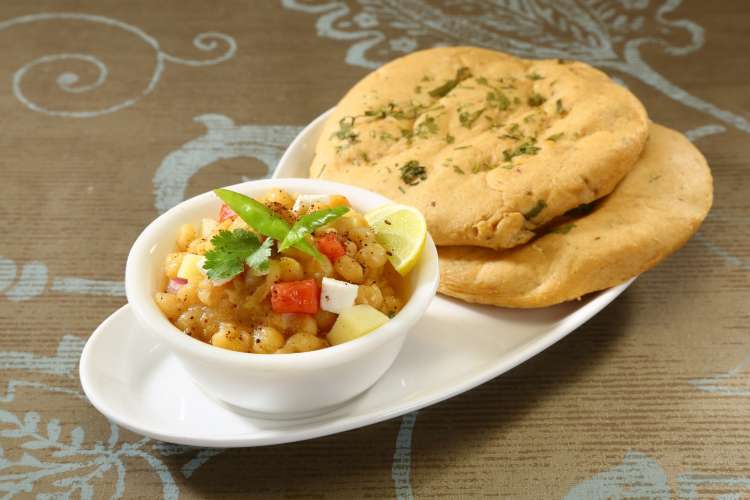
12. Dosa
Dosas are an icon of South Indian food, with a legacy dating back to ancient times. Made from fermented lentil and rice flour batter, the thin pancakes or crêpes are served hot and either folded in half or rolled like a wrap.
They are usually eaten with chutney or sambar, a South Indian lentil and vegetable stew. Variations of dosa contain different combinations of fillings and sauces with regional varieties of dough ingredients and preparation methods.
- Pairs With: Coconut chutney, tomato chutney or sambar.
- Spice Level: Generally mild; chutneys and fillings determine the heat.
- Suitable For: Vegetarian and vegan diets (depending on use of ghee or butter).
- Cooking Notes: Requires soaking, grinding and fermenting the batter; cooked like a crêpe on a flat griddle.
- Where To Buy: Best enjoyed fresh at South Indian restaurants. Pre-made batters and frozen dosas are available at Indian grocery stores.
13. Vada Pav
Vada pav is a vegetarian street food dish native to the central state of Maharashtra, which is home to the city of Mumbai. The popular dish consists of a deep-fried potato dumpling inside a soft bread bun accompanied by chutneys and green chile peppers.
Vada pav, also called a Bombay Burger, was created in the mid-20th century as an affordable and nourishing dish for workers and holds an important place in the city’s culture and political history. There’s even a World Vada Pav Day, celebrated annually on August 23.
- Pairs With: Dry garlic chutney, fried green chile or sweet tamarind chutney.
- Spice Level: Medium to high. Green chile adds serious heat, but spice levels can be adjusted.
- Suitable For: Vegetarian; vegan if pav is made without butter or milk.
- Cooking Notes: Boiled potatoes are spiced, shaped, battered and deep-fried; pav buns are lightly toasted or served plain.
- Where To Buy: Found across Mumbai at street stalls and small eateries. Some Indian bakeries and grocery stores carry frozen vada pav kits.
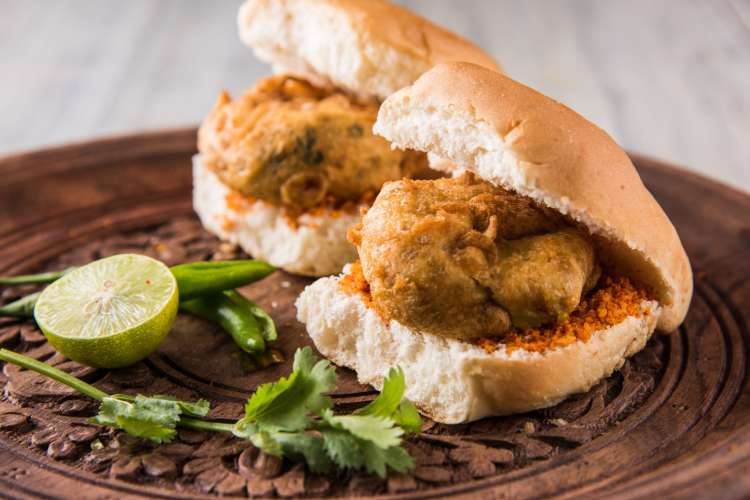
14. Misal Pav and Pav Bhaji
The soft bread roll, or pav, is an important element in several Indian street food dishes, including misal pav and pav bhaji. These Maharashtrian street foods consist of a lentil or vegetable curry paired with a roll for dipping the savory, spiced gravies. Both dishes can be found with a wide variety of pairings and presentations.
Both dishes can be found with a wide variety of pairings and presentations. Pav bhaji is hearty, rich and buttery, with the bhaji mashed to a smooth consistency and served with toasted, buttered pav.
Misal pav, on the other hand, is more layered, often starting mild but finishing with a sharp heat, thanks to its spiced lentil base and crunchy toppings. Both are deeply satisfying, especially when served hot.
- Pairs With: Raw onions, lemon wedges, green chile and extra pav for soaking up the curry.
- Spice Level: Pav bhaji is typically medium; misal pav can be much spicier depending on the region (Kolhapuri misal is known for its heat).
- Suitable For: Vegetarian; vegan if butter is omitted from pav and bhaji.
- Cooking Notes: Pav bhaji involves mashed vegetables cooked with butter and spice mix; misal pav features sprouted lentils in a spiced gravy topped with sev (crispy noodles).
- Where To Buy: Widely available at Indian street food stalls and Maharashtrian restaurants. Pav bhaji mixes and ready-made gravies are also sold in Indian grocery stores.
15. Kathi Rolls
Originally from Kolkata in the West Bengal state of India, kathi rolls began as a skewer-roasted kebab wrapped in paratha bread. Modern kathi rolls refer to practically any wrap with a filling folded in an Indian flatbread and containing ingredients such as eggs, chicken, mutton, chutney or chilies. The filled wrap is rolled up in paper for easy eating on the go.
Kathi rolls are practical, filling and adaptable. The paratha holds up well to a variety of hot or cold fillings, and the dish works as a full meal or a quick snack depending on portion size and ingredients.
- Pairs With: Mint chutney, pickled onions, ketchup or chile sauce, depending on region and filling.
- Spice Level: Mild to hot, depending on the protein and sauces used.
- Suitable For: Varies. Commonly non-vegetarian, but vegetarian and even vegan versions are widely available.
- Cooking Notes: Paratha is cooked on a griddle, filled with grilled or spiced ingredients, and rolled in parchment or foil.
- Where To Buy: Street food stalls, fast-casual Indian restaurants and food courts. DIY kits and frozen options exist in Indian grocery stores.
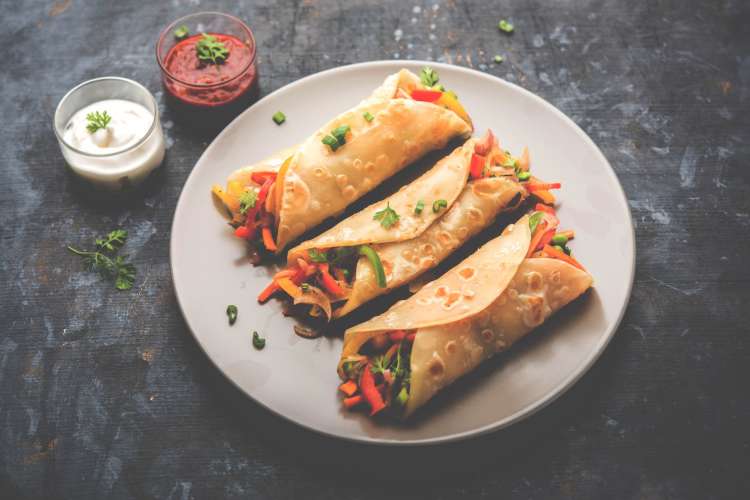
16. Frankie
Similar to a kathi roll is the frankie, a street food wrap popular in Mumbai. Also called a Mumbai or Bombay Burrito, these hearty wraps are filled with fresh or cooked vegetables, spiced potatoes, chickpeas, pickled onions and sauces and then rolled in a soft, thin flatbread.
Frankies are filling and convenient, especially for on-the-go meals. The bread is softer than a traditional paratha, and the fillings are often milder in spice compared to other Indian wraps.
- Pairs with: Mint chutney, tamarind sauce or plain yogurt.
- Spice Level: Mild to moderate. Spice level depends on the chutney and filling.
- Suitable For: Vegetarian by default; vegan versions available depending on ingredients used in the flatbread and sauces.
- Cooking Notes: Flatbread is warmed, then filled and rolled; ingredients like potatoes or chickpeas are typically pre-cooked and seasoned.
- Where To Buy: Commonly found at Mumbai food stalls and Indian fast-casual eateries. Some frozen options and ready-to-fill wraps are available in Indian grocery stores.
Indian Appetizers
Sometimes overlapping with snacks and street foods, Indian appetizers start the meal with tantalizing spices, contrasting textures and a nod to the diverse cultural influences and legendary creations that make up this unique segment of Indian cuisine.
17. Pakora
Pakora, also known as bhaji among other names, are spiced vegetable fritters deep-fried and eaten as a snack, street food or appetizer. These crispy fritters are often accompanied by tamarind sauce, chutney or raita and are a popular food at Indian weddings.
While vegetable pakoras are the most common, chicken pakoras are also widely served. They are made using a similar batter but with marinated chicken pieces, offering a crisp exterior and tender interior. Both versions are served hot and are typically eaten fresh, as they lose their texture over time.
- Pairs With: Tamarind chutney, mint chutney, green chile sauce or raita.
- Spice Level: Moderate; can vary depending on batter seasoning and dipping sauces.
- Suitable For: Vegetarian (vegetable version); non-vegetarian (chicken pakora).
- Cooking Notes: Vegetables or marinated chicken are dipped in a seasoned gram flour batter and deep-fried until golden.
- Where To Buy: Available at Indian restaurants and street stalls. Frozen versions are also sold in grocery stores.

18. Gobi Manchurian
Gobi Manchurian is an Indo-Chinese appetizer commonly found on menus at Indian restaurants at home and abroad. The word gobi in Hindi means cauliflower, while Manchurian refers to the Chinese style of cooking adapted to create the signature sweet and sour sauce as it made its way into the Indian subcontinent, especially in the West, around cities like Kolkata.
This popular appetizer is a classic vegetarian dish that represents this particular style of Indian food. From what we’ve tried, it’s best eaten immediately after cooking, the cauliflower stays crisp and the sauce retains its balance of heat, tang and slight sweetness.
- Pairs With: Hakka noodles, fried rice or served alone as a starter.
- Spice Level: Typically moderate; some versions can be quite spicy.
- Suitable For: Vegetarian; vegan if no dairy is used in the batter or sauce.
- Cooking Notes: Cauliflower florets are coated in a seasoned batter, deep-fried and then tossed in a soy-based sauce with garlic, ginger and chile.
- Where To Buy: Common on Indo-Chinese menus at Indian restaurants. Also available frozen or as a ready mix in Indian grocery stores.
19. Chicken 65
Although its origins remain awash with myths, the renowned Chicken 65 is well established as the invention of A.M. Buhari, named for the year of its creation in 1965. The spicy, deep-fried chicken dish appeared on the menu of the Buhari Hotel in the state of Tamil Nadu.
The menu later added versions of the dish called Chicken 78, Chicken 82 and Chicken 90, some of which are still served at the historic hotel today. These are considered among the best Indian food dishes associated with the restaurant’s legacy.
In practice, Chicken 65 is a hot, crisp, dry-style dish that’s typically served as a starter. It’s best eaten hot, right out of the fryer, when the coating is still crunchy and the spices are most pronounced.
- Pairs With: Indian basmati rice, sliced onions, lemon wedges, naan or as part of Chicken 65 biryani.
- Spice Level: High, typically made with red chile, black pepper and garlic.
- Suitable For: Non-vegetarian diets.
- Cooking Notes: Boneless chicken is marinated in yogurt, spices and chile powder, then deep-fried and sometimes tossed with curry leaves and green chile.
- Where To Buy: Found at South Indian restaurants and food stalls. Frozen versions are sold in some Indian grocery stores.
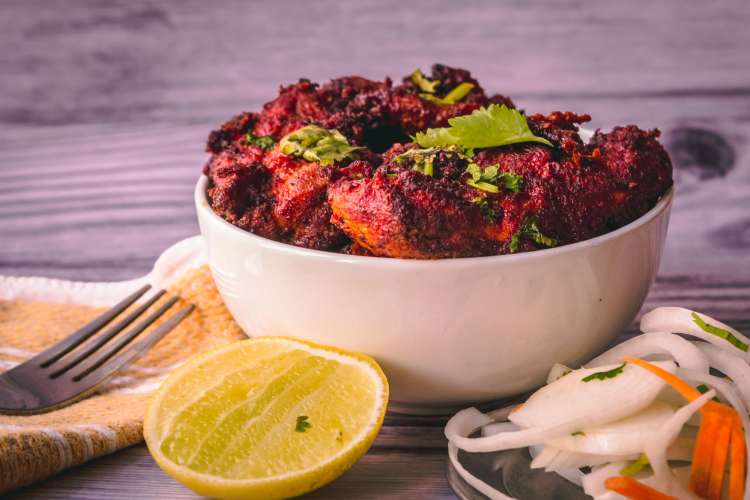
20. Momos
Momos are steamed dumplings hailing from Eastern India and areas of China, Tibet and Nepal. These hearty dumplings are typically filled with minced meat or tofu with vegetables and served with spicy chutney or a clear noodle soup called thukpa.
Momos are most enjoyable when served hot, with the outer wrapper soft and slightly chewy, and the filling well-seasoned. While steamed is the most common version, pan-fried and deep-fried options are also popular in Indian street food settings.
- Pairs With: Spicy red chile chutney, garlic sauce or thukpa (noodle soup).
- Spice Level: Mild in the filling; chutneys often provide most of the heat.
- Suitable For: Vegetarian or non-vegetarian diets, depending on the filling; vegan options are available.
- Cooking Notes: Dough is rolled thin, filled with seasoned mixture and steamed or fried; shaping requires some technique.
- Where To Buy: Common at Indo-Tibetan stalls in Northeast India and metro cities. Frozen momos are widely available in Indian and international grocery stores.
21. Sambar
The South Indian lentil-based vegetable stew, sambar, is often cooked with pigeon peas and tamarind broth. A well-balanced sambar is tangy, mildly spiced and deeply aromatic from ingredients like mustard seeds, curry leaves and asafoetida. It’s commonly served as part of both everyday meals and traditional South Indian breakfasts.
- Pairs With: Rice, dosa or idli, a type of savory rice cake made by steaming a fermented batter of rice and lentils.
- Spice Level: Mild to moderate; varies by region and amount of chilies used.
- Suitable For: Vegetarian and vegan diets.
- Cooking Notes: Cooked lentils are simmered with tamarind, vegetables and spices; tempering is added at the end for flavor.
- Where To Buy: Found in South Indian restaurants. Ready-made mixes and packaged versions are available in Indian grocery stores.
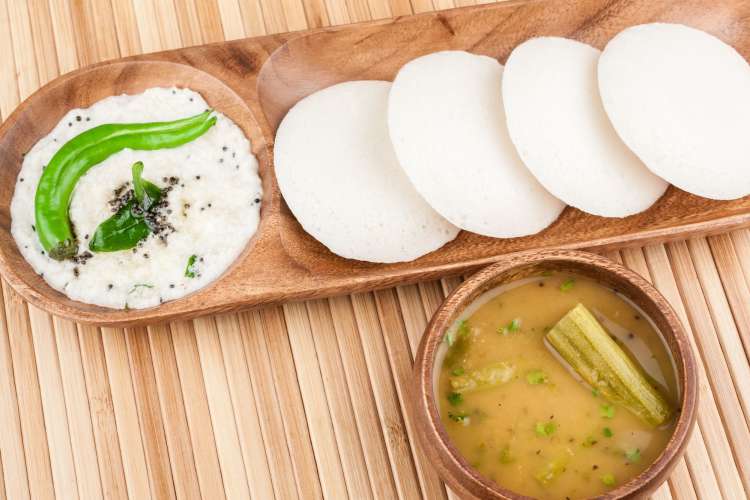
22. Medu Vada
Medu vada is a savory fried snack typically made of spiced black lentils in the shape of a small doughnut. This Indian food is soft on the inside with a crispy exterior and is generally eaten for breakfast or as a starter in South India, although it can be found across the country. Medu vada is often served with sambar and coconut chutney.
When freshly made, medu vada has a light, crisp crust and a soft, spongy interior that holds up well when dipped into hot sambar or thick chutney. It’s filling, protein-rich and commonly served as part of a traditional South Indian breakfast plate.
- Pairs With: Sambar, coconut chutney or tomato chutney.
- Spice Level: Mild; flavor comes primarily from black pepper, ginger and curry leaves in the batter.
- Suitable For: Vegetarian and vegan diets.
- Cooking Notes: Black gram dal is soaked, ground into a thick batter, seasoned, shaped by hand and deep-fried.
- Where To Buy: Widely available at South Indian restaurants and tiffin stalls. Frozen and ready-to-fry versions can be found in Indian grocery stores.
Indian Dishes
Cooking styles and techniques for preparing Indian food vary greatly amongst the Northern, Western, Eastern and Southern regions of the country. The result of history, geography and migration, each region has signature styles and dishes that differentiate these unique types of Indian food from one another.
Northern Indian food is recognized for its use of dairy products like yogurt, ghee and paneer, as well as fried snacks like samosas, rich stews and tandoor-cooked dishes. Western Indian food reflects its landscape: Goa features Portuguese-inspired dishes; Gujarat offers mostly vegetarian fare with some Chinese influence; and Maharashtra leans on seafood, with coconut milk–based curries.
Eastern India is known for its desserts and Tibetan and Nepali influences, while Southern Indian food is diverse with bright curries, tangy sauces, dosas and regional thali. Of all these, Northern Indian food is most commonly found in Indian restaurants outside of the country, though other regional styles are beginning to gain international recognition.
When it comes to the names of Indian food dishes, keep in mind that masala means a blend of spices, and curry refers to a spiced sauce usually named to reflect the main ingredients such as aloo (potato), dal (lentil), chana (chickpea) or saag (spinach).
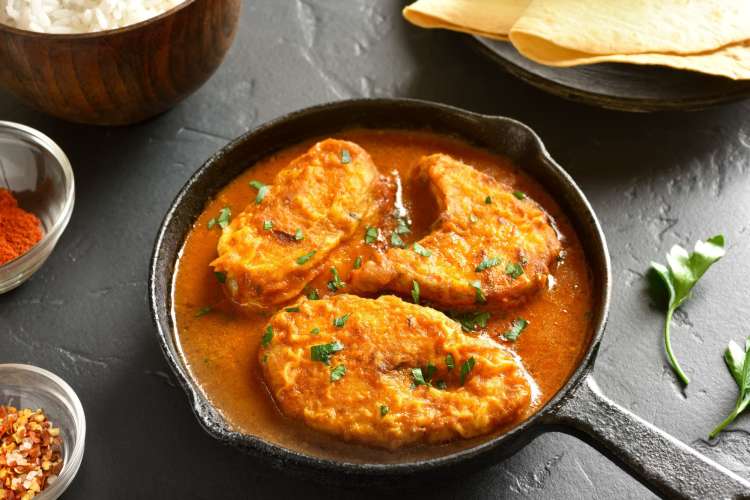
23. Tandoori
An iconic food from India, dishes labeled tandoori are typically breads or meats that have been seasoned and cooked at high temperatures in a tandoor oven. Tandoori chicken is probably the most well-known dish of this style. It consists of chunks of chicken marinated in spiced yogurt and available in a variety of heat levels.
Well-prepared tandoori dishes are defined by a charred exterior, tender interior and a deep smoky flavor that only the tandoor can produce. The marinade helps retain moisture while layering the meat with spices that range from mildly tangy to intensely hot.
- Pairs With: Naan, basmati rice, cucumber dip or green chutney.
- Spice Level: Varies widely. From mild and smoky to very spicy, depending on the marinade.
- Suitable For: Non-vegetarian (chicken, lamb, fish); vegetarian options include paneer and mushrooms.
- Cooking Notes: Ingredients are marinated in yogurt and spices, then cooked in a clay tandoor or high-heat oven.
- Where To Buy: Found at nearly all Indian restaurants. Marinades and ready-to-cook tandoori products are widely sold in Indian grocery stores.

24. Tikka Masala
You might be interested to learn that the iconic chicken tikka masala, one of the most popular Indian dishes, did not originate in India. It is believed to have been popularized by Indian cooks living in Great Britain, drawing inspiration from butter chicken.
This widely recognized dish usually features roasted and marinated boneless chicken in a creamy, bright orange, tomato-based curry made with coconut milk and a blend of spices.
While chicken is the traditional protein, vegan tikka masala made with tofu or vegetables is a common and widely available alternative. Both versions are considered among the best Indian food options for those who enjoy rich curries with layered spice.
- Pairs With: Basmati rice, naan, roti or a side of cucumber raita.
- Spice Level: Mild
- Suitable For: Non-vegetarian (chicken); vegetarian and vegan versions available with tofu, chickpeas or vegetables.
- Cooking Notes: Marinated protein is roasted and simmered in a tomato-based curry made with coconut milk or cream and a spice blend.
- Where To Buy: Common in Indian restaurants worldwide. Jarred sauces, spice kits and ready meals are available in grocery stores.
25. Butter Chicken
Traditionally known as murgh makhani, butter chicken is a luscious dish originating in the 1950s in Northern India. Marinated chicken is cooked in a tandoor before being served in a rich, spiced tomato and butter sauce. Vegetarian versions of this dish can also be found on Indian restaurant menus with paneer instead of chicken.
A well-prepared butter chicken stands out for its smooth texture and balance of mild spices, cream and acidity from the tomatoes. It remains one of the best Indian food dishes for those who prefer richness and flavor without intense heat.
- Pairs With: Basmati rice, naan, roti or jeera (cumin) rice.
- Spice Level: Mild to moderate; often creamy with just a hint of chile.
- Suitable For: Non-vegetarian (chicken); vegetarian versions available with paneer.
- Cooking Notes: Chicken is marinated in yogurt and spices, grilled or roasted, then simmered in a sauce made with butter, cream and tomatoes.
- Where To Buy: Widely available at Indian restaurants. Jarred sauces, frozen meals and meal kits are commonly sold in grocery stores.
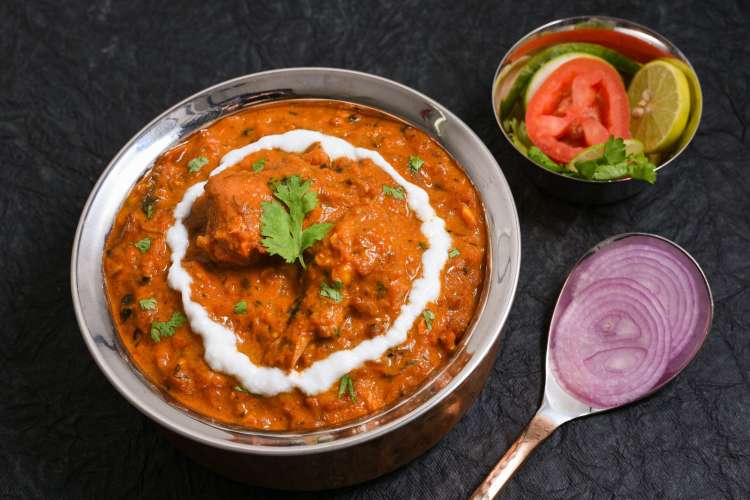
26. Korma
Korma is a style of curry that is creamy and fragrant, with meat or vegetables braised in a mixture of coconut milk, yogurt, spices and often almonds or cashews. Navratan korma is a vegetarian korma made with either vegetables or paneer.
Korma is known for its subtle heat and richness, making it a good option for those new to Indian food or looking for something milder. Vegan curry versions of korma are also widely available, often substituting dairy with plant-based milks (like coconut milk or cashew cream) while keeping the same aromatic base.
- Pairs With: Basmati rice, paratha or naan.
- Spice Level: Mild; more aromatic than spicy.
- Suitable For: Vegetarian, vegan (when dairy is substituted), and non-vegetarian versions are all common.
- Cooking Notes: Ingredients are simmered in a spiced sauce thickened with yogurt or coconut milk, sometimes with ground nuts for texture.
- Where To Buy: Offered at Indian restaurants; ready-made sauces and vegan curry mixes are available in grocery stores.
27. Malai Kofta
This North Indian comfort food is made with kofta, fried potato-paneer dumplings, served in a rich, creamy sauce. The dumplings can come in a variety of sizes with either a lightly colored cream sauce or a spicier orange curry with tomatoes and red chilies.
When prepared well, the kofta is soft inside with a crisp outer layer that holds up in the sauce. The dish is filling, mildly spiced and often served on special occasions or as part of a restaurant-style meal.
- Pairs With: Naan, paratha, or basmati rice.
- Spice Level: Mild to moderate, depending on the sauce variation.
- Suitable For: Vegetarian diets.
- Cooking Notes: Kofta are made from mashed potatoes and paneer, deep-fried, then served in a tomato or cream-based curry.
- Where To Buy: Commonly found at North Indian restaurants. Frozen versions and meal kits are available in Indian grocery stores.
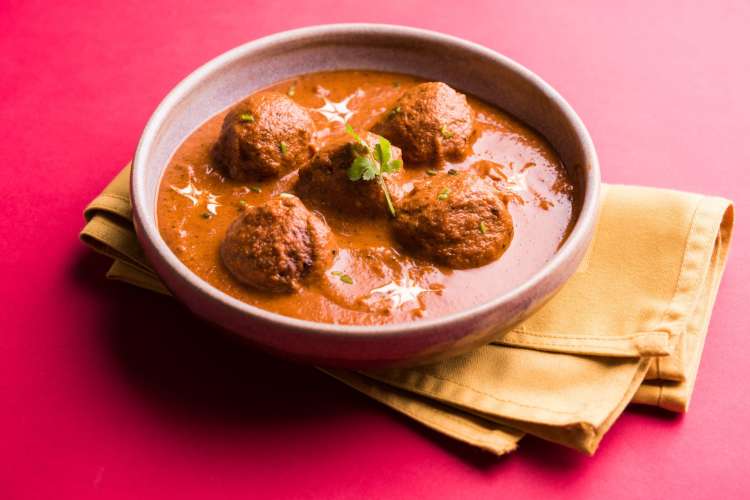
28. Vindaloo
The notoriously spicy vindaloo curry originated in the Goa region of India, drawing from a Portuguese dish of garlic-marinated pork. Traditionally made with pork marinated in vinegar and garlic, this fiery Indian food can be made with meat or prepared vegetarian, but it always includes lots of spices and hot chilies.
Lamb vindaloo is a popular variation of this Indian food, especially in Indian restaurants outside of Goa, and is known for its bold flavor and heat. The combination of acidity from the vinegar and intensity from the spices gives the dish its distinct character.
- Pairs With: Steamed rice, roti or naan.
- Spice Level: High, often one of the spiciest options on the menu.
- Suitable For: Non-vegetarian (commonly pork, chicken or lamb); vegetarian versions use potatoes or paneer.
- Cooking Notes: Meat is marinated in vinegar, garlic and spices, then slow-cooked in a chili-forward curry.
- Where To Buy: Found at Goan or general Indian restaurants. Spice mixes and sauces are available in Indian grocery stores.
29. Rogan Josh
This aromatic curried meat dish from Kashmir, in the far north of India, traditionally features braised lamb, mutton or goat along with warm spices and bold Kashmiri chilies. To develop its rich, signature color, rogan josh should be stewed low and slow to ensure tender meat and an intense depth of flavor.
This dish is typically more spiced than hot, and the slow-cooking method gives the sauce a thick consistency and deep flavor. When prepared properly, the dish is well-balanced and is often served as part of a larger Kashmiri meal.
- Pairs With: Steamed basmati rice or naan.
- Spice Level: Moderate; flavor comes more from spices than heat.
- Suitable For: Non-vegetarian diets (commonly made with lamb or goat).
- Cooking Notes: Meat is braised with onions, yogurt and a blend of spices including cardamom, cinnamon and Kashmiri chile.
- Where To Buy: Available at North Indian restaurants. Spice blends for Rogan Josh are also sold in Indian grocery stores.

30. Karaikudi Curry
Karaikudi curry, also known as Chettinad curry, is a unique South Indian food often prepared with mutton and grated coconut, although it can be made with chicken, fish, paneer or vegetables as well. The distinct use of coconut, chilies and freshly ground spices in the Tamil Nadu region gives this South Indian food its signature heat and depth of flavor.
This curry stands out for its bold spice profile and thick, rustic texture. It’s a dish that leaves a lasting impression without relying on heavy cream or butter.
- Pairs With: Steamed rice, dosa, parotta or idiyappam (string hoppers).
- Spice Level: High, often includes dried red chilies and black pepper.
- Suitable For: Non-vegetarian and vegetarian diets, depending on the protein used.
- Cooking Notes: Coconut and whole spices are roasted and ground into a paste, then simmered with meat or vegetables.
- Where To Buy: Served at South Indian and Chettinad-style restaurants. Chettinad spice mixes are sold in Indian grocery stores.
31. Saag
Saag sets itself apart from other Indian food dishes by eschewing the bright oranges and reds of many Indian curries for a deep, distinctive green provided by its signature ingredient: spinach. Other leafy green vegetables such as fenugreek, mustard greens, collard greens or dill help round out the flavor of the dish.
As with other styles of curry, popular versions of saag are made with meat, fish or vegetarian paneer. The flavor is mild and earthy, and the texture is thicker than most curries. It’s a good option for anyone looking for something hearty without a lot of spice.
- Pairs With: Makki ki roti (corn flatbread), basmati rice or naan.
- Spice Level: Mild; most versions are not spicy unless chilies are added.
- Suitable For: Vegetarian, vegan (if made without cream or paneer).
- Cooking Notes: Leafy greens are cooked down with spices and puréed; sometimes finished with cream or butter.
- Where To Buy: Served at Punjabi and North Indian restaurants. Frozen and ready-to-eat versions are available in Indian grocery stores.
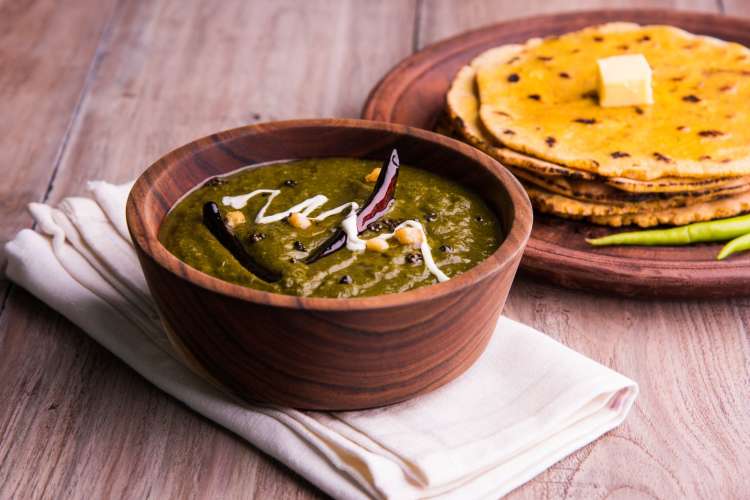
32. Dal Tadka
Dal tadka is a cozy Indian food made of hearty lentils tempered in ghee or oil and spices. The comforting simplicity of dal tadka makes it one of the most popular Indian dishes. With a largely vegetarian population, Indian food incorporates many legumes such as lentils and chickpeas as a source of protein and nutrients, making dishes like these Indian food staples.
This dish is filling without being heavy and pairs well with both rice and flatbreads. It’s consistently served as part of everyday meals and is a reliable option for anyone looking for something flavorful and nourishing.
- Pairs With: Steamed rice, roti, jeera rice or papadam.
- Spice Level: Mild to moderate.
- Suitable For: Vegetarian and vegan diets (if prepared with oil instead of ghee).
- Cooking Notes: Lentils are boiled until soft, then tempered with garlic, cumin and other spices in ghee or oil.
- Where To Buy: Common in Indian restaurants. Ready-to-eat pouches and mixes are widely available in grocery stores.
33. Chana Masala
This iconic Indian food is a North Indian curry dish made with white chickpeas simmered in a spiced tomato and onion gravy. This vegetarian dish is commonly enjoyed on its own or soaked up by rice or naan.
Dry versions of chana masala (without gravy) are also eaten as a snack or street food. It’s a dish that’s widely available and easy to prepare, which makes it a practical choice for both home cooks and restaurant menus. The chickpeas hold their shape well and absorb the flavor of the spices, offering a meal that’s both hearty and balanced.
- Pairs With: Basmati rice, naan, puri or jeera rice.
- Spice Level: Medium; can be adjusted with more or less chile.
- Suitable For: Vegetarian and vegan diets.
- Cooking Notes: Cooked chickpeas are simmered with tomatoes, onions, garlic and a blend of ground spices.
- Where To Buy: Common in Indian restaurants and food courts. Canned or frozen versions are available in Indian and international grocery stores.
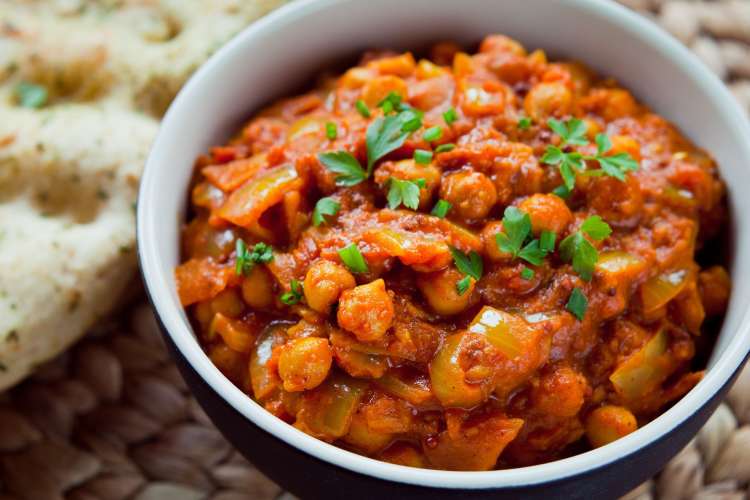
34. Aloo Gobi
Aloo gobi is a simple Indian food of spiced potatoes and cauliflower. This everyday dish can be found in a variety of styles, from dry to curried, with each family and restaurant having its own recipe for the vegetarian staple.
A similar dish, aloo matar, uses green peas instead of cauliflower and is just as common across Indian households and restaurants. Both are versatile and frequently made as part of everyday meals. These Indian foods are a dependable option when you want something filling, flavorful and not overly spiced.
- Pairs With: Roti, paratha, rice or as part of a thali.
- Spice Level: Mild to moderate, depending on the use of green chilies or garam masala.
- Suitable For: Vegetarian and vegan diets.
- Cooking Notes: Potatoes and vegetables are simmered or sautéed with turmeric, cumin, coriander and sometimes tomato.
- Where To Buy: Widely available at Indian restaurants. Also sold as frozen meals or shelf-stable pouches in grocery stores.
35. Biryani
Biryani is a classic Indian dish popularized by Muslim communities across India. It is similar to Persian pilaf or pulao. The spiced rice dish can be found with many variations, though generally, it consists of meat, fish and/or vegetables and rice cooked separately before being layered and cooked together so that the gravy can be absorbed into the rice.
Regional and seasonal versions of this traditional Indian food may include rich or sweet ingredients such as nuts or fruit and may be accompanied by a selection of chutneys, raita, pickles or salad. This staple Indian food has roots across many cultures, with dozens of cuisines from South Africa to the Philippines sharing a version of the mixed rice dish.
In our experience, the layering method is key to what sets biryani apart from simpler rice dishes; each spoonful brings a combination of flavor, spice and texture. Some versions of this Indian food are mild and aromatic, while others bring significant heat, depending on the region.
- Pairs With: Raita, boiled egg, onion salad, lemon wedges or pickle.
- Spice Level: Moderate to high, depending on the preparation.
- Suitable For: Non-vegetarian and vegetarian diets; vegan versions are possible with adjustments.
- Cooking Notes: Rice and protein or vegetables are cooked separately with spices, then layered and steamed together to blend flavors.
- Where To Buy: Widely available at Indian restaurants and takeout spots; frozen and ready-to-eat versions are sold in grocery stores.
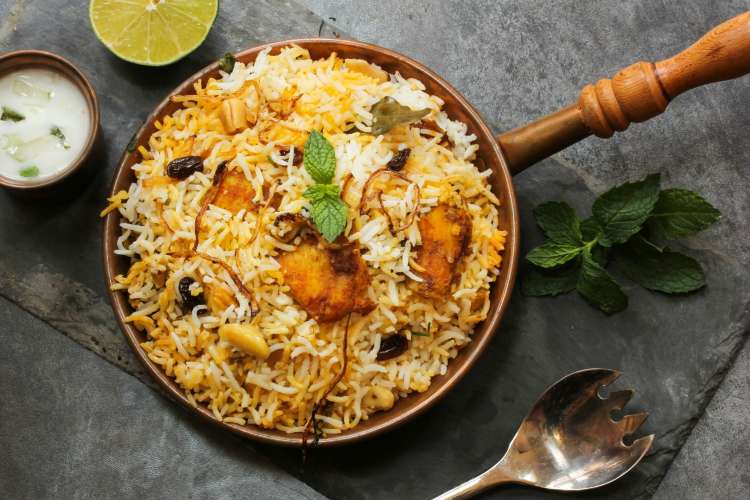
36. Kadai Chicken
A kadai is a deep, rounded vessel for cooking Indian food. It is similar to a wok with two looped handles for easy transport. To make this North Indian food, marinated chicken is cooked in the kadai with onions, tomatoes, bell peppers and spices, then finished with fresh cream.
The dish is usually served semi-dry with a thick, chunky sauce. We’ve found it to be a good choice when looking for a meal that emphasizes bold spice without being overly saucy or heavy. The use of freshly ground spices gives it a distinct aroma and flavor compared to other chicken curries.
- Pairs With: Naan, roti or jeera rice.
- Spice Level: Moderate to high, depending on the amount of chile and pepper used.
- Suitable For: Non-vegetarian diets.
- Cooking Notes: Chicken is marinated and sautéed with bell peppers, tomatoes, onions, and a spice blend; cream is added at the end.
- Where To Buy: Common at North Indian restaurants. Spice mixes labeled "Kadai Masala" are available in Indian grocery stores.
37. Thali
Thali refers more to a style of eating than a particular Indian food, but it holds an important place in traditional Indian cuisine. A thali is a round platter used to serve food in South Asia and the Caribbean. It is also the name for an Indian-style meal made up of a variety of dishes served together, sometimes designated for ceremonial purposes.
The idea behind thali is to present all of the six different flavors together on one single plate: sweet, salty, bitter, sour, astringent and spicy. According to Indian food customs, a meal should balance all six flavors.
Thali dishes vary across regions and are usually served in small bowls on a tray or banana leaf. Typical dishes might include rice, dal, vegetables, roti, yogurt, chutney or pickles, and something sweet.
What stands out from Thali is how the variety allows you to experience multiple textures and flavors without needing to order separately. It’s one of the most efficient and balanced ways to sample a range of Indian food in a single sitting.
- Pairs With: Served as a complete meal; sometimes includes papadam or a lassi on the side.
- Spice Level: Varies by dish. Thalis usually include both mild and spicy components.
- Suitable For: Vegetarian, vegan or non-vegetarian diets depending on region and occasion.
- Cooking Notes: Multiple dishes are prepared in small portions, often including dal, a curry, a dry vegetable, rice, flatbread and dessert.
- Where To Buy: Available at many Indian restaurants, especially those offering regional cuisine. Also common during festivals and in traditional Indian homes.
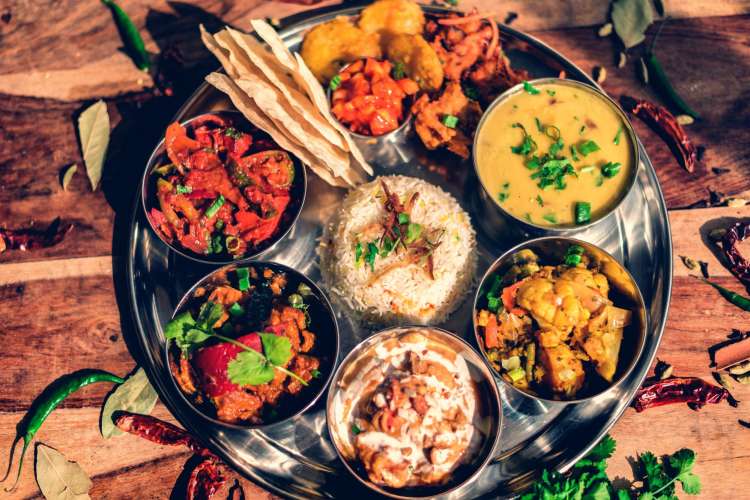
Indian Desserts
An exploration of Indian food would not be complete without a selection of signature sweets and desserts. According to HospitalityWorld from the Economic Times, Indian desserts have long been rooted in tradition and are closely tied to cultural celebrations and everyday meals.
In recent years, there has been a growing interest in blending traditional elements with modern flavors and presentation. This reflects both continuity and change in how these sweets are enjoyed today.
38. Gajar Ka Halwa
Like so many Indian foods, halwa draws inspiration from the nation’s history and neighboring cuisines, with several varieties found across the country. Gajar ka halwa is a simple dessert made from grated carrots simmered in milk and cardamom before being fried in ghee and sugar and garnished with dried fruit.
This colorful dessert is often enjoyed during both Hindu and Muslim festivals throughout India. It's especially popular during winter months, when it's served warm and freshly made. The combination of slow-cooked carrots, rich dairy and subtle spice makes this dish familiar yet celebratory.
- Pairs With: Served on its own or with a scoop of vanilla ice cream.
- Spice Level: None; flavored with cardamom and occasionally saffron.
- Suitable For: Vegetarian diets; can be made vegan with dairy substitutes.
- Cooking Notes: Carrots are grated and simmered with milk, sugar, ghee and cardamom, then cooked down until thick.
- Where To Buy: Often available at Indian sweet shops, restaurants and in frozen or ready-to-eat packs at Indian grocery stores.
39. Kulfi
Sometimes called traditional Indian ice cream, kulfi is a frozen dairy dessert that comes in a variety of flavors. The dense, creamy custard is slow to melt in the Indian heat and comes in flavors ranging from saffron and mango to vanilla and rose.
Unlike regular ice cream, kulfi isn’t churned, which gives it a firmer texture and more intense flavor. It’s often sold on sticks or in small earthenware cups and is a common dessert option at weddings, street stalls and festivals.
- Pairs With: Eaten on its own or served with falooda (sweet vermicelli noodles).
- Spice Level: None; sweet and sometimes lightly floral or nutty.
- Suitable For: Vegetarian diets.
- Cooking Notes: Milk is simmered and reduced, then sweetened and flavored before freezing in molds.
- Where To Buy: Available at Indian restaurants, ice cream stands and in frozen sections of Indian grocery stores.
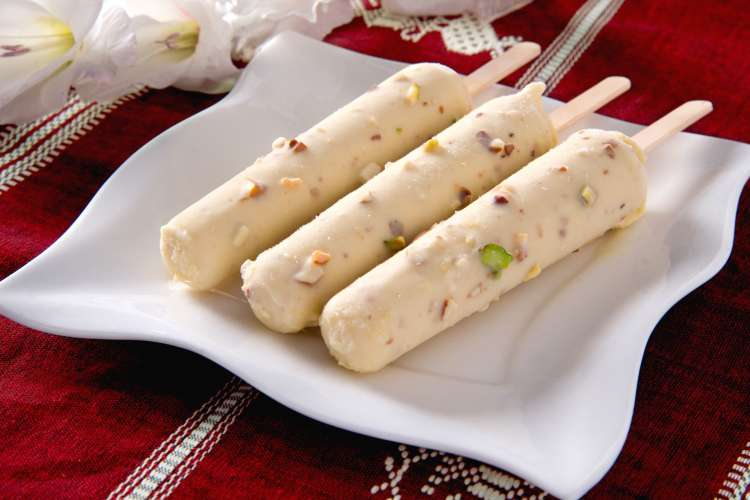
40. Kheer
When it comes to dessert, Indian food is well known for its variety of sweetened milk puddings, with kheer being perhaps the most beloved among them. Kheer is made by boiling rice with milk and sugar. It is then garnished with coconut, saffron, cardamom, dried fruits and nuts.
It’s typically served warm or chilled depending on the occasion, and its creamy texture and mild sweetness make it a familiar comfort dish across regions. Versions of this Indian food also use ingredients like vermicelli or tapioca, but the rice-based version remains the most common.
- Pairs With: Often served on its own as dessert or part of a thali.
- Spice Level: None; subtly flavored with cardamom or saffron.
- Suitable For: Vegetarian diets; can be made vegan with plant-based milk.
- Cooking Notes: Rice is simmered in milk and sugar until thick, then finished with spices and garnishes.
- Where To Buy: Found at Indian restaurants, especially during lunch buffets or festive meals; ready-to-eat versions are sold in Indian grocery stores.
41. Gulab Jamun
Gulab jamun is a classic Indian dessert made from deep-fried milk solids, or khoya, which is milk that has been reduced to the consistency of a soft dough. The fried balls are soaked in a sweet syrup flavored with cardamom and rose water and sometimes garnished with almonds or cashews.
This syrupy sweet Indian food is a popular dessert for festivals, birthdays and major celebrations. The texture is soft and slightly spongy, and the syrup gives it a rich, aromatic finish.
- Pairs With: Served on its own or occasionally with vanilla ice cream.
- Spice Level: None; sweet with floral and spice notes from rose water and cardamom.
- Suitable For: Vegetarian diets.
- Cooking Notes: Khoya is kneaded into dough, shaped, deep-fried, and soaked in warm sugar syrup.
- Where To Buy: Commonly available at Indian sweet shops, restaurants, and available canned or frozen in Indian grocery stores.
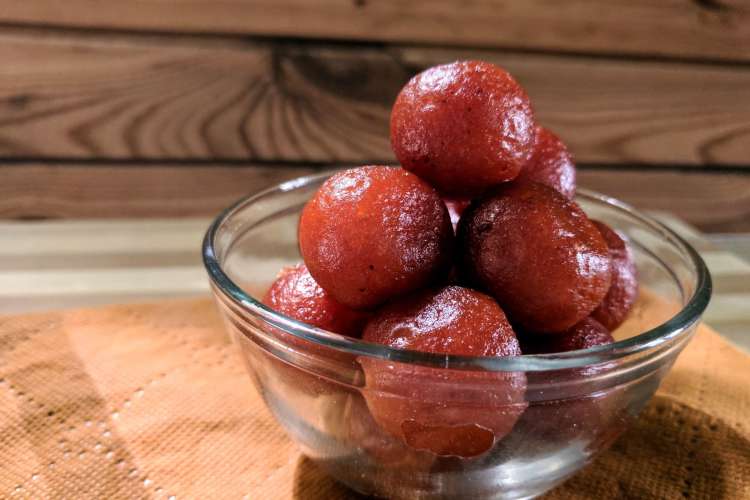
42. Ras Malai
Ras Malai is a famous Indian food from West Bengal often attributed to the renowned Bengali confectioner, Krishna Chandra Das from Kolkata. This dessert consists of creamy flattened dough balls made of Indian cottage cheese soaked in a thick, sweetened condensed milk.
The dish is typically flavored with cardamom or rose water and finished with saffron, almonds or pistachios.The texture is soft and light, and the milk absorbs just enough sweetness to balance the richness. It’s often served chilled and is especially common during festivals and special occasions.
- Pairs With: Served as a standalone dessert, often chilled.
- Spice Level: None; lightly flavored with cardamom, saffron or rose water.
- Suitable For: Vegetarian diets.
- Cooking Notes: Paneer (chhena) is formed into discs, cooked, then soaked in flavored, sweetened milk.
- Where To Buy: Found in Indian sweet shops and restaurants. Also sold frozen or in vacuum-sealed packs at Indian grocery stores.
43. Barfi
The base of this sweet Indian food is made up of just two ingredients: milk powder and sugar. The ingredients are cooked down until the mixture solidifies into a dense treat that can be cut into shapes and flavored or decorated with fruits, spices or rose water.
Barfi has a fudge-like texture that varies slightly by recipe and region. It’s commonly offered during religious festivals, weddings and as part of gift boxes, and its long shelf life makes it one of the most widely shared Indian sweets. Popular flavorings include cardamom, coconut, pistachio and mango.
- Pairs With: Served as a dessert or gifted during celebrations.
- Spice Level: None; usually sweet with mild flavor additions.
- Suitable For: Vegetarian diets.
- Cooking Notes: Milk solids or milk powder are cooked with sugar and ghee, then flavored and set to cool before cutting.
- Where To Buy: Available year-round at Indian sweet shops and during festivals at grocery stores.

44. Mysore Pak
A popular treat from South India, Mysore pak is a traditional dessert made with gram flour, sugar and lots of ghee. It is similar to a dense, buttery cookie, but with a signature porous texture.
This unique Indian food, said to have been created to impress the Maharaja of Mysore, is often shared at weddings, baby showers and other festivals and celebrations. The texture can range from soft and melt-in-your-mouth to firm and crumbly, depending on how it’s made.
It’s rich and heavy, so it’s typically served in small squares. Trust us, a little goes a long way!
- Pairs With: Served on its own, usually at the end of a festive meal.
- Spice Level: None; sweet with a strong ghee flavor.
- Suitable For: Vegetarian diets.
- Cooking Notes: Gram flour is roasted and combined with hot sugar syrup and ghee, then set to cool and cut.
- Where To Buy: Widely available at South Indian sweet shops and Indian grocery stores, especially during festivals.
Indian Drinks
Some of the must-try Indian foods are not foods at all, but instead beverages. From cool and creamy fruit drinks to warm, spiced tea, classic Indian drinks are the perfect complement to traditional Indian dishes.
45. Lassi
This refreshing beverage is the perfect addition to a spicy Indian meal. The creamy, yogurt-based lassi, often blended with fruit such as mango, banana or strawberry, is a delicately sweet and tangy way to cool down on a hot day. In addition to the fruit versions, salty lassis seasoned with cumin or black salt are also common in many parts of India.
From our experience, it’s one of the best ways to take the edge off a heavily spiced curry, the cooling effect is immediate. We’ve found sweet mango lassi to be especially satisfying, while the versions with a hint of cumin feel more like a mid-meal reset.
- Pairs With: Spicy curries or biryani, or as a cooling drink on its own.
- Spice Level: None; sweet or mildly spiced depending on the version.
- Suitable For: Vegetarian diets.
- Cooking Notes: Yogurt is blended with water or milk, sweetener or salt, and optional flavorings like fruit or spices.
- Where To Buy: Available at Indian restaurants, juice stands, and bottled in grocery stores.

46. Masala Chaas
Also known as spiced buttermilk, masala chaas is the halfway point between a lassi and masala chai with its unique blend of creamy dairy and a bite of spice. This cooling, yogurt-based beverage is mildly spicy with green chilies, ginger and black peppercorns and a refreshing, minty finish.
You’ll probably find it served chilled after a heavy lunch, especially in warmer regions where something light and salty helps with digestion. The balance of cooling yogurt and warming spices makes it feel both soothing and revitalizing, a reliable companion to deeper, richer flavors in Indian cuisine.
- Pairs With: Fried snacks like pakora, spicy curries, biryani.
- Spice Level: Mild; flavor-forward with cumin, ginger and herbs.
- Suitable For: Vegetarian diets.
- Cooking Notes: Blend yogurt with water, salt, ground cumin, herbs, and a touch of chile or ginger.
- Where To Buy: Best made fresh at home, though bottled versions can sometimes be found in Indian grocery stores
47. Masala Chai
Possibly the best-known Indian beverage is a hot masala chai. Tea is beloved across India, with one of the most popular being this distinctive black tea mixed with Indian herbs and spices such as cardamom, cinnamon, cloves, ginger and black peppercorns. This spiced tea blend is mixed with milk to make a warm, creamy cup of classic masala chai.
The aroma alone is enough to draw you in, but it’s the bold, comforting mix of spices that makes each sip feel grounding. It’s commonly served in small glasses at roadside tea stalls.
- Pairs With: Biscuits, samosas, pakora or breakfast dishes.
- Spice Level: Mild and aromatic.
- Suitable For: Vegetarian diets.
- Cooking Notes: Simmer black tea with water, milk, whole spices and sweetener.
- Where To Buy: Found at Indian restaurants, cafés or as pre-made blends in most grocery stores.
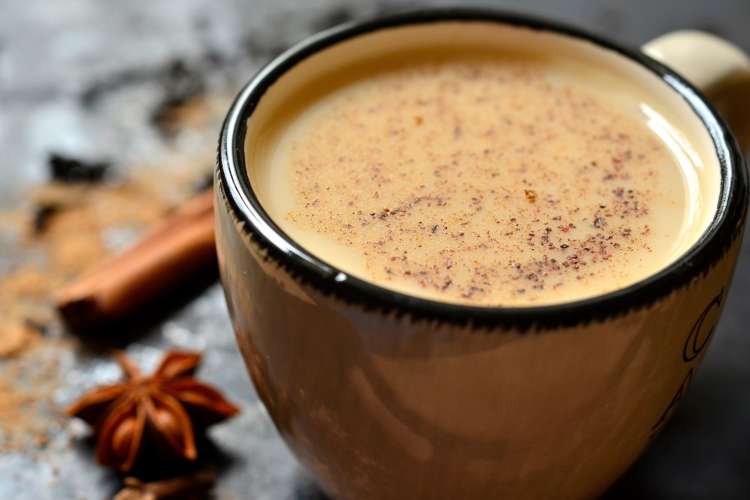
48. Jal Jeera
Jal jeera is a popular summer drink similar to lemonade. Bright green in color, jal jeera is flavored with a spice blend known as jaljira powder, which consists of cumin, ginger, black pepper, mint, black salt, fruit powder such as mango or citrus, and chile or hot pepper powder.
Jaljira is an ancient blend originating along the banks of the Ganges river and is said to have medicinal properties that aid digestion and cooling.
- Pairs With: Street food, fried snacks or served on its own as an aperitif.
- Spice Level: Mild, with a tangy flavor..
- Suitable For: Vegan and vegetarian diets.
- Cooking Notes: Mix jaljira powder with chilled water and optionally add lemon juice or ice.
- Where To Buy: Commonly found in Indian households. Jaljira powder is sold at Indian markets and some international grocery stores.
49. Aam Panna
Another drink known for its cooling properties is aam panna. This refreshing, chilled beverage is made from unripe mangoes, spices and mint leaves that give it a yellow or light green color.
The ingredients in this sour, thirst-quenching drink have been known to help prevent loss of nutrients and excessive sweating in the intense summer heat. They also serve as a tonic against upset stomach and other ailments.
- Pairs With: Spicy snacks, grilled foods or enjoyed on its own as a summer cooler.
- Spice Level: Mild; focus is on tang and refreshment.
- Suitable For: Vegan and vegetarian diets.
- Cooking Notes: Boil peeled raw mangoes, blend with sugar, salt, spices and mint, then chill and dilute with water.
- Where To Buy: Often homemade, but bottled versions are sold in Indian grocery stores.

Indian Spices
An essential element of traditional Indian dishes that sets them apart from other cuisines is the adept use of a wide variety of Indian spices and aromatics. The seven fundamental spices of Indian food include cardamom, cumin, clove, turmeric, coriander, cinnamon and fenugreek, although many more commonly appear throughout the diverse range of classic Indian dishes.
Depending on the region, the different types of Indian food utilize herbs and spices in unique ways that distinguish them from other areas of the country. While some spices such as garlic, ginger, cinnamon, nutmeg and black pepper are generally familiar in the West, the delicately balanced blends of regional spices are what give Indian food its distinct depth of flavor.
Common spices of India include:
- Turmeric: A brightly golden-hued spice, widely recognized as a superfood and known for its warm, peppery notes and earthy undertone.
- Ginger: Sweet, warm and spicy with earthy citrus notes.
- Garlic: A strong aromatic related to onions with a sharp spiciness and sulfuric undertones. Sometimes chopped or made into a paste. Cloves of garlic may also be fire-roasted.
- Cumin: An earthy, warm and aromatic member of the parsley family that can be used ground or as whole seeds. Widely used in Indian food and spice blends.
- Cardamom: Both green and black cardamom have a strong fragrance and are commonly used in Indian food. Black cardamom has a smoky aroma with a cooling sensation similar to mint.
- Saffron: Crimson threads from the Crocus sativus flower with notes of metallic honey and grass or hay. Imparts a rich, yellow hue.
- Coriander: Imparts a tart, citrus or nutty taste sometimes interpreted as reminiscent of dish soap. Fresh coriander is often used for garnish on a wide variety of popular Indian dishes. Also known as cilantro, both the dried seeds and fresh leaves are used in Indian food.
- Garam Masala: A blend of ground spices widely used across Indian cuisines, with ingredients differing according to region. Usually consists of coriander, cumin, cardamom, cloves, black pepper, cinnamon and nutmeg, among other common Indian spices, adding warmth and sweetness as well as floral notes and a touch of heat to classic Indian dishes.
- Asafoetida: A pungent, gum-like substance exuded from the tap root of perennial herbs in the celery family. Enhances savory flavors in vegetarian dishes and helps balance flavors in popular Indian dishes such as rogan josh.
- Fenugreek: Can be used as an herb, spice or vegetable and has a distinctive maple syrup scent, with a wide range of applications across Indian cuisines.
- Tej Patta: Also known as Indian bay leaves, with a strong aroma reminiscent of cinnamon and clove.
- Fennel: Used across different types of Indian food from Kashmiri to Bengali, with a strong anise aroma similar to licorice. Sometimes used as a breath freshener.
- Star Anise: Used to prepare traditional Indian dishes such as biryani and masala chai, with a strong anise aroma.
- Nutmeg/Mace: Pungent aroma with a warm, slightly sweet taste. Mace is made from the reddish covering of the nutmeg seed and is similar, but more delicate in flavor.
- Clove: Highly aromatic spice of the evergreen family often paired with other warm spices such as cinnamon, nutmeg and star anise to lend flavor to curries, marinades or desserts.
- Carom: Also known as ajwain, highly fragrant with a scent similar to thyme with bitter notes reminiscent of oregano and anise with earthy, minty undertones.
- Mustard Seed: Commonly added to spicy fish dishes and Indian pickles, with a robust, tangy flavor and aroma.
- Indian Red Chilies: Varieties can be used fresh or dried, whole or ground into a powder to amplify the heat level in traditional Indian foods such as curries, pickles and chutneys.
- Curry Leaves: Widely used in South and West Indian cooking, with a pungent, bitter flavor similar to asafoetida with undertones of citrus leaves and lemongrass.
- Mint: An aromatic herb used in Indian food and drinks with a distinct fragrance and cooling sensation.
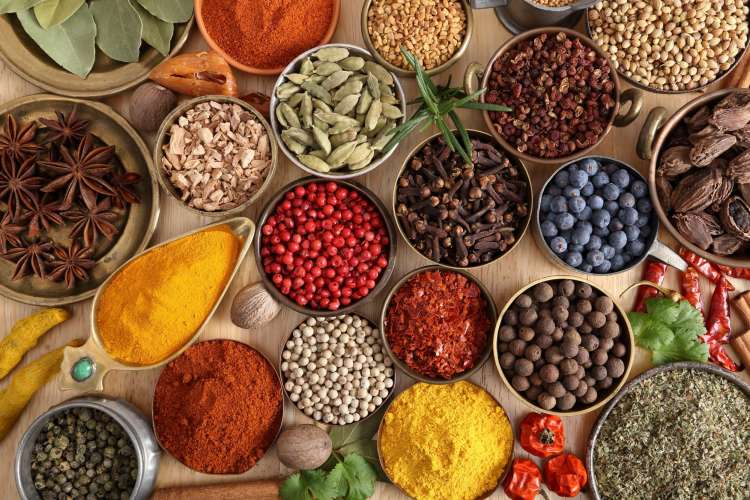
Get a Taste of Traditional Indian Foods
One of the best ways to get to know a cuisine is to practice making it yourself. A great way to learn how to recreate the iconic flavors of Indian food at home is with hands-on cooking classes led by world-class chefs. You can explore the influence of history, geography and culture of Indian food and how Indian food names and ingredients reflect its regional cuisines.
With Indian cooking classes in the Bay Area, in NYC and other culinary classes near you, talented chefs will teach you traditional techniques for building depth of flavor and balancing the signature spices to craft authentic Indian food. If you can’t find a class in your area, we recommend discovering the distinctive stories and spices of this iconic cuisine virtually with interactive Indian cookery classes online.
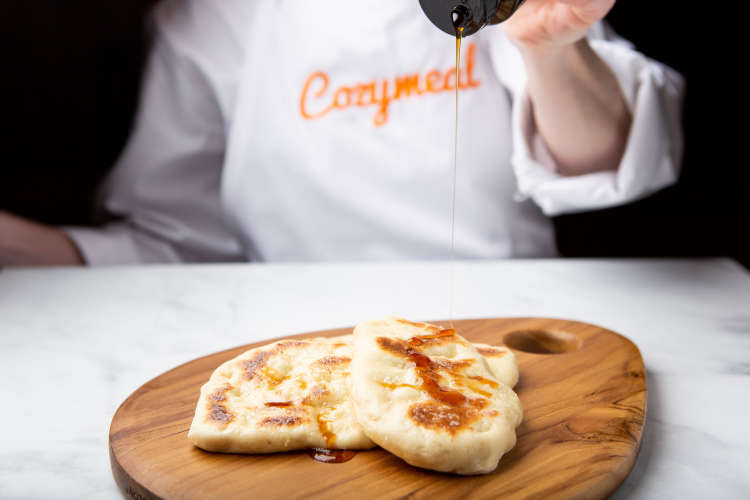
For those new to Indian food, branching out into Indian cuisine at restaurants or buffets can feel a bit intimidating. With some insight into the historical and cultural context of Indian food, along with how to decipher some Indian food names, trying new and different food from India can be fun and exciting rather than daunting.
From distinctive breads and deep-fried street foods to rich curries and cooling beverages, Indian food is brimming with an alluring array of colors, textures and aromatic spices to discover. Whether you're exploring it dish by dish or diving into a full thali, Indian food offers something memorable for every palate.
For even more fun ways to explore food, check out other experiences happening on Cozymeal.




FOOD FOR THOUGHT?
Join the conversation.